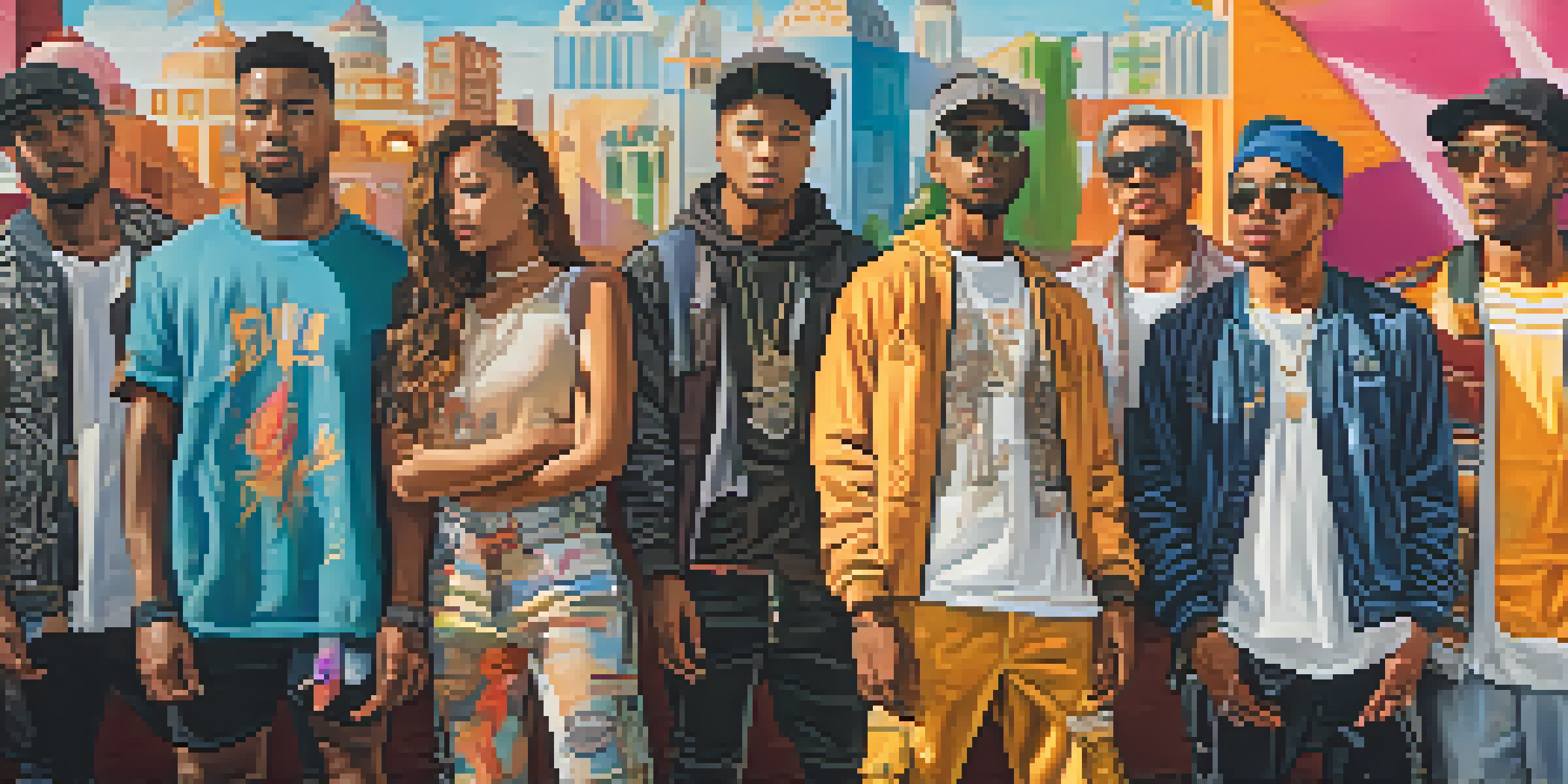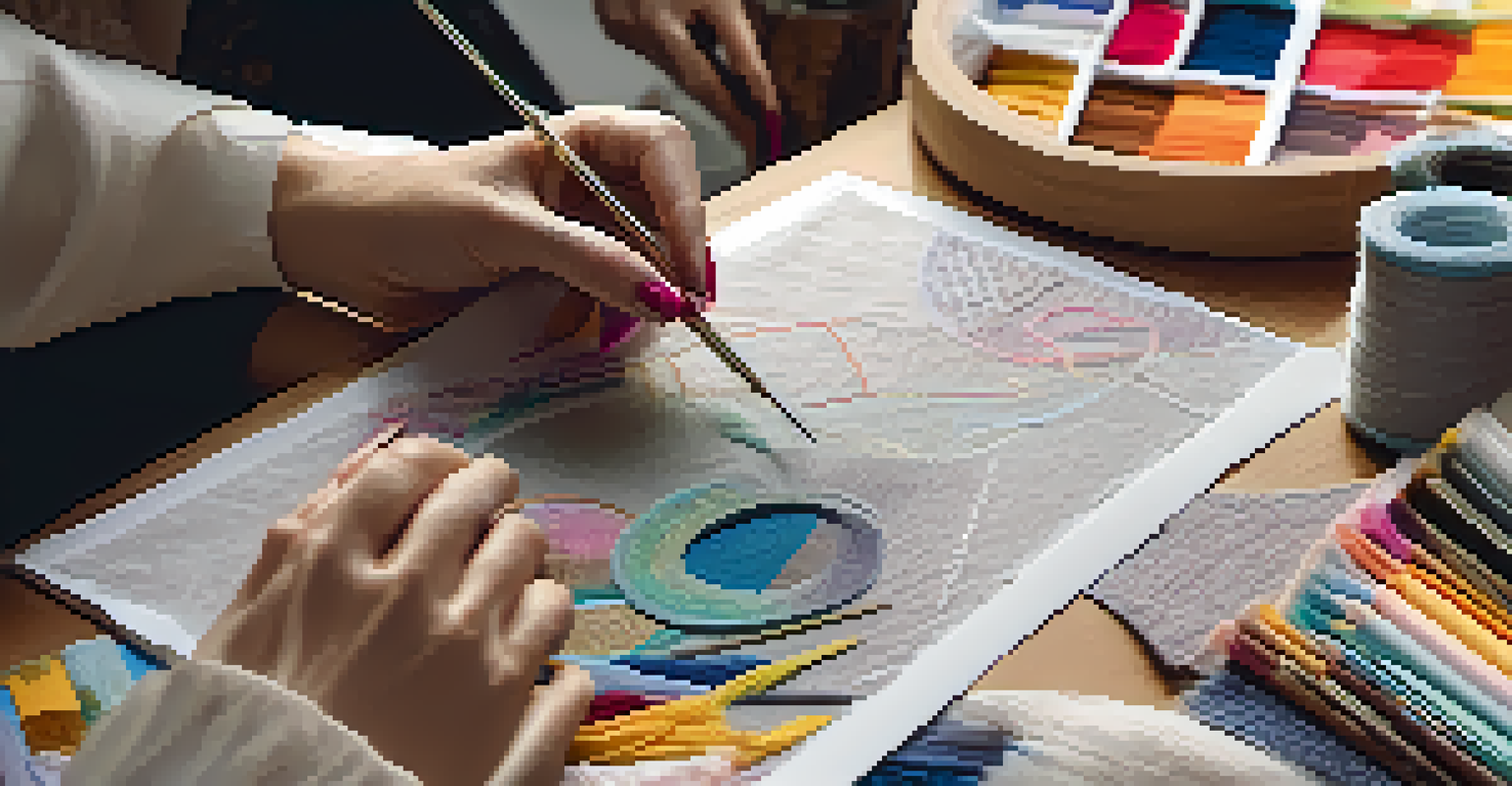Fashion Icons: Their Influence on Visual Arts and Culture

The Role of Fashion Icons in Shaping Culture
Fashion icons have the unique ability to transcend mere clothing; they embody cultural movements and ideologies. From Coco Chanel's revolutionary designs to the bold statements made by Rihanna, these figures often reflect societal values and challenges. Their styles can inspire collective identity, making them pivotal in shaping not just fashion, but also broader cultural narratives.
Fashion is the armor to survive the reality of everyday life.
For instance, think about how the punk movement in the '70s used fashion as a form of rebellion. Icons like Vivienne Westwood didn’t just create clothing; they sparked conversations about individuality and resistance. This interplay between fashion and culture shows how icons can drive social change, making their influence profound and far-reaching.
Ultimately, fashion icons serve as mirrors of their times, capturing the ethos of their eras. Their impact goes beyond the runway and seeps into art, music, and even politics, reminding us that style is often a reflection of the world around us.
Iconic Fashion Moments and Their Artistic Impact
Certain fashion moments have left indelible marks on the visual arts, merging creativity and style in unforgettable ways. Take, for example, the legendary 1960s mini skirt popularized by Mary Quant, which not only influenced fashion but also inspired artists like Andy Warhol. This cross-pollination between fashion and art has led to unique collaborations and movements.

Another iconic moment is the rise of the 'supermodel' in the '90s, where figures like Naomi Campbell and Kate Moss became synonymous with high fashion. Their presence in various art forms—from photography to painting—highlighted the aesthetic power of fashion, elevating it to an art form in its own right. This has encouraged a dialogue about beauty standards and representation that continues to evolve.
Fashion Icons Shape Cultural Narratives
Fashion icons reflect societal values and drive social change through their influential styles.
These moments illustrate how fashion is not just about garments; it's about expression and identity. The interplay between fashion and art fosters a creative dialogue that enriches both fields, demonstrating the profound impact of fashion icons on the visual landscape.
The Influence of Fashion Icons on Contemporary Artists
Contemporary artists often draw inspiration from fashion icons, creating work that reflects or critiques their influence. For instance, the works of artists like Kehinde Wiley and Jeff Koons often incorporate elements of fashion to explore themes of identity, race, and consumerism. This blending of art and fashion highlights how these icons can shape artistic narratives.
Clothes mean nothing until someone lives in them.
Moreover, the resurgence of streetwear and its integration into high fashion has blurred the lines between art and apparel. Artists are now using their platforms to launch fashion lines, further intertwining these disciplines. This shift emphasizes the importance of fashion as a valid form of artistic expression, challenging traditional definitions of art.
As a result, fashion icons become not just muses but collaborators in the artistic process. Their influence is seen in how contemporary artists approach their work, signaling a dynamic relationship that continues to evolve and inspire.
Fashion Icons and Their Role in Social Change
Fashion icons have historically played crucial roles in advocating for social change. Figures like Audrey Hepburn and Jackie Kennedy not only set trends but also used their platforms to promote humanitarian causes. Their fashion choices often reflected their values, transcending the realm of style to become powerful symbols for change.
In recent years, icons like Zendaya and Billy Porter have used their visibility to challenge gender norms and encourage inclusivity in fashion. Their bold sartorial choices at major events have sparked conversations about representation, pushing the fashion industry to embrace diversity. This activism shows how fashion can be a vehicle for broader societal messages.
Art and Fashion Intertwine Creatively
Iconic fashion moments have significantly impacted visual arts, creating a dialogue between style and artistic expression.
Thus, fashion icons are not just trendsetters; they are agents of change. Their influence encourages individuals and brands alike to reflect on their values, illustrating the power of style in advocating for social justice.
The Intersection of Fashion and Technology
The rise of technology has transformed the landscape of fashion, and icons are at the forefront of this evolution. From social media influencers to virtual fashion shows, today's icons are leveraging technology to reach wider audiences and redefine fashion accessibility. This shift has opened up new avenues for creativity and expression.
For example, the use of augmented reality (AR) in fashion allows consumers to try on garments virtually, which has been embraced by icons like Kim Kardashian. This not only enhances the shopping experience but also challenges traditional fashion marketing strategies. It’s fascinating to see how technology reshapes consumer interactions with fashion icons.
As technology continues to advance, fashion icons will likely evolve with it, finding innovative ways to engage with their audiences. This intersection of fashion and technology promises to create exciting possibilities for future trends, making style more interactive and immersive.
Cultural Appropriation vs. Cultural Appreciation in Fashion
Fashion icons often walk a fine line between cultural appreciation and cultural appropriation, a topic that has sparked significant debate. When designers and celebrities draw inspiration from different cultures, it's essential to consider the context and respect behind those influences. Understanding the difference can foster a more inclusive fashion landscape.
Take, for instance, the case of certain festival wear that borrows elements from Indigenous cultures. While some argue it's a form of appreciation, others believe it trivializes deep-rooted traditions. Fashion icons have the power to either perpetuate or challenge these narratives, emphasizing the need for sensitivity and awareness.
Cultural Sensitivity in Fashion Choices
Fashion icons must navigate the fine line between cultural appreciation and appropriation to promote inclusivity.
Navigating this complex terrain is crucial for the future of fashion. By promoting cultural appreciation, fashion icons can play a vital role in encouraging respectful dialogue and understanding, ultimately enriching the industry and fostering a more inclusive environment.
The Future of Fashion Icons in a Globalized World
As we move towards a more globalized world, the concept of fashion icons is evolving. No longer confined to a single geographical location, today's icons can emerge from diverse backgrounds, showcasing a variety of styles and cultural influences. This shift reflects the interconnectedness of our society and the democratization of fashion.
Platforms like Instagram and TikTok have accelerated this change, allowing anyone with a unique style to gain recognition as a fashion icon. This democratization challenges traditional hierarchies in the fashion industry, emphasizing individuality and personal expression. Icons are now defined by their authenticity rather than their status.

Looking ahead, the future of fashion icons will likely be characterized by an even greater emphasis on inclusivity and diversity. As more voices are heard, the fashion landscape will continue to evolve, celebrating the richness of global cultures and the unique contributions of various individuals.